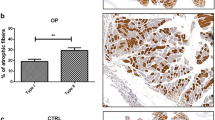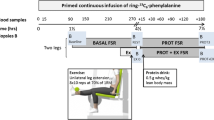Abstract
The aim of this study was to investigate the effect of 12-week resistance training on morphological presence of collagen and RAGE (receptor for advanced glycation end products) in skeletal muscle of patients with knee osteoarthritis (OA). Little is known about the influence of exercise on the skeletal muscle matrix that supports joints affected by OA mainly when it is associated with medication taken by OA patients (non-steroid anti-inflammatory drugs (NSAID) and glucosamine). A biopsy was collected from the vastus lateralis muscle in all patients before and after 12-week period of training. The patients (age 55–69 years) were divided into three groups, treated with NSAID, glucosamine or placebo. In addition, the muscle samples were analysed by immunohistochemistry for collagen types, RAGE and capillaries ratio. An increment in immunoreactivity for type IV collagen after the training period was observed in 72 % of all biopsies when compared with their respective baseline samples. Reduced immunoreactivity of collagen type I was observed in all patients treated with glucosamine. A significant increase with training in the amount of RAGE was detected in the placebo group only (p < 0.05). Comparison of post-treatment states indicated significant differences between the placebo and glucosamine group data, demonstrating increased levels in the placebo group (p < 0.05). These findings suggest a basement membrane remodelling in favour of a strengthened extracellular matrix surrounding individual muscle fibres after 12 weeks of resistance training. Glucosamine with training appeared to attenuate RAGE accumulation more than was seen with NSAID or placebo in skeletal muscle of OA patients.


Similar content being viewed by others
References
Freemont AJ, Hoyland JA (2007) Morphology, mechanisms and pathology of musculoskeletal ageing. J Pathol 211:252–259
Bennell KL, Hunt MA, Wriley TV, Lim BW, Hinman RS (2008) Role of muscle in genesis and management of knee osteoarthritis. Rheum Dis Clin North Am 34:731–754
Slemenda C, Brandt KD, Heilman DK, Mazzuca S, Braunstein EM, Katz BP, Wolinsky FD (1997) Quadriceps weakness and osteoarthritis of the knee. Ann Intern Med 127:97–104
Sirca A, Susec-Michieli M (1980) Selective type II fibre muscular atrophy in patients with osteoarthritis of the hip. J Neurol Sci 44:149–159
Schmitt LC, Rudolph KS (2007) Influences on knee movement strategies during walking in persons with medial knee osteoarthritis. Arthritis Rheum 57:1018–1026
Sharma L, Pai Y (1997) Impaired proprioception and osteoarthritis. Curr Opin Rheumatol 9:253–258
Lephart SM, Pincivero DM, Giraldo JL, Fu FH (1997) The role of proprioception in the management and rehabilitation of athletic injuries. Am J Sports Med 25:130–137
Bierhaus A, Stern DM, Nawroth PP (2006) RAGE in inflammation: a new therapeutic target? Curr Opin Investig Drugs 7:985–991
Hirose J, Yamabe S, Takada K, Okamoto N, Nagai R, Mizuta H (2011) Immunohistochemical distribution of advanced glycation end products(AGEs) in human osteoarthritic cartilage. Acta Histochem 113:613–618
Haus JM, Carrithers JA, Trappe SW, Trappe TA (2007) Collagen, cross-linking, and advanced glycation end products in aging human skeletal muscle. J Appl Physiol 103:2068–2076
Ducomps C, Mauriege P, Darche B, Combes S, Lebas F, Doutreloux JP (2003) Effects of jump training on passive mechanical stress and stiffness in rabbit skeletal muscle: role of collagen. Acta Physiol Scand 178:215–224
Willems ME, Miller GR, Stauber WT (2001) Force deficits after stretches of activated rat muscle-tendon complex with reduced collagen cross-linking. Eur J Appl Physiol 85:405–411
Kovanen V, Suominen H, Risteli J, Risteli L (1988) Type IV collagen and laminin in slow and fast skeletal muscle in rats- effects of age life-time endurance training. Coll Relat Res 8:145–153
Goldspink G, Fernandes K, Williams PE, Wells DJ (1994) Age-related changes in collagen gene expression in the muscles of mdx dystrophic and normal mice. Neuromuscul Disord 4:183–191
Smith K, Rennie MJ (2007) New approaches and recent results concerning human-tissue collagen synthesis. Curr Opin Clin Nutr Metab Care 10:582–590
de La Maza MP, Uribarri J, Olivares D, Hirsch S, Leiva L, Barrera G, Bunout D (2008) Weight increase is associated with skeletal muscle immunostaining for advanced glycation end products, receptor for advanced glycation end products, and oxidation injury. Rejuvenation Res 11:1041–1048
Neeper M, Schmidt AM, Brett J, Yan SD, Wang F, Pan YC, Elliston K, Stern D, Shaw A (1992) Cloning and expression of a cell surface receptor for advanced glycosylation end products of proteins. J Biol Chem 267:14998–15004
Yan SF, D’Agati V, Schmidt AM, Ramasamy R (2007) Receptor for advanced glycation end products (RAGE): a formidable force in the pathogenesis of the cardiovascular complications of diabetes and aging. Curr Mol Med 7:699–710
Semba RD, Nicklett EJ, Ferrucci L (2010) Does accumulation of advanced glycation end products contribute to the aging phenotype? J Gerontol A Bio Sci Med Sci 65A:963–975
Bierhaus A, Humpert PM, Morcos M, Wendt T, Chavakis T, Arnold B, Stern DM, Nawroth PP (2005) Understanding RAGE, the receptor for advanced glycation end products. J Mol Med 83:876–886
Haslbeck KM, Friess U, Schleicher ED, Bierhaus A, Nawroth PP, Kirchner A, Pauli E, Neundorfer B, Heuss D (2005) The RAGE pathway in inflammatory myopathies and limb girdle muscular dystrophy. Acta Neuropathol 110:247–254
Kurose T, Asai Y, Mori E, Daitoku D, Kawamata S (2006) Distribution and change of collagen types I and III and elastin in developing leg muscle in rat. Hiroshima J Med Sci 55:85–91
Schall R (1991) Estimation in generalized linear models with random effects. Biometrika 78:719–727
Mackey AL, Donnelly AE, Turpeenniemi-Hujanen T, Roper HP (2004) Skeletal muscle collagen content in humans after high-force eccentric contractions. J Appl Physiol 97:197–203
Mackey AL, Donnelly AE, Roper HP (2005) Muscle connective tissue content of endurance-trained and inactive individuals. Scand J Med Sci Sports 15:402–408
Ramaswamy KS, Palmer ML, van der Meulen JH, Renoux A, Kostrominova TY, Michele DE, Faulkner JA (2011) Lateral transmission of force is impaired in skeletal muscles of dystrophic mice and very old rats. J Physiol 589:1195–1208
Lehto M, Duance VC, Restall D (1985) Collagen and fibronectin in healing skeletal muscle injury. An immunohistological study of the effects of physical activity on repair of injured gastrocnemius muscle in rat. J Bone Joint Surg Br 67:820–828
Hindle AG, Horning M, Mellish JA, Lawler JM (2009) Diving into old age: muscular senescence in a large-bodied, long-lived mammal, the Weddell seal (Leptonychotes weddellii). J Exp Biol 212:790–796
Kovanen V, Suominen H (1989) Age-and training-related changes in the collagen of rat skeletal muscle. Eur J Appl Physiol Occup Physiol 58:765–771
Polizello JC, Carvalho LC, Freitas FC, Padula N, Martinez EZ, Mattiello-Sverzut AC (2011) Morphological effects of resumption of reloading after immobilization in lengthened position of skeletal muscle of female rats. Braz J Physical Therapy 15:73–79
Mackey AL, Brandstetter S, Schjerling P, Bojsen-Moller J, Qvortrup K, Pedersen MM, Doessing S, Kjaer M, Magnusson SP, Langberg H (2011) Sequenced response of extracellular matrix deadhesion and fibrotic regulators after muscle damage is involved in protection against future injury in human skeletal muscle. Faseb J 25:1943–1959
Granic I, Dolga AM, Nijholt IM, van Dijk G, Eisel UL (2009) Inflammation and NF-kappaB in Alzheimer’s disease and diabetes. J Alzheimers Dis 16:809–821
Kramer HF, Goodyear LJ (2007) Exercise, MAPK, and NF-kappaB signaling in skeletal muscle. J Appl Physiol 103:388–395
Reginster JY, Deroisy R, Rovati LC, Lee RL, Lejeune E, Bruyere O, Giacovelli G, Henrotin Y, Dacre JE, Gossett C (2001) Long-term effects of glucosamine sulphate on osteoarthritis progression: a randomized, placebo-controlled clinical trial. Lancet 357:251–256
Xing R, Liu S, Guo Z, Yu H, Li C, Ji X, Feng J, Li P (2006) The antioxidant activity of glucosamine hydrochloride in vitro. Bioorg Med Chem 14:1706–1709
Petersen SG, Saxne T, Heinegard D, Hansen M, Holm L, Koskinen S, Stordal C, Christensen H, Aagaard P, Kjaer M (2010) Glucosamine but not ibuprofen alters cartilage turnover in osteoarthritis patients in response to physical training. Osteoarthritis Cartilage 18:34–40
Petersen SG, Beyer N, Hansen M, Holm L, Aagaard P, Mackey AL, Kjaer M (2011) NSAID or glucosamine treatments reduced pain and improved muscle strength gain with resistance training in knee osteoarthritis patients. Arch Phys Med Rehabil 92:1185–1193
Durmus D, Alayli G, Aliyazicioglu Y, Buyukakincak O, Canturk F (2012) Effects of glucosamine sulphate and exercise therapy on serum leptin levels in patients with knee osteoarthritis: preliminary results of randomized controlled clinical trial. Rheum Int. doi:10.1007/s00296-012-2401-9
Acknowledgments
A.C. Mattiello-Sverzut was recipient of postdoctoral fellowships from Coordenação de Aperfeiçoamento de Pessoal de Nível Superior (CAPES), Brazil (Grants n.0641.08.1). This work was supported by the Danish Rheumatism Association, Nordea Foundation (Healthy Aging grant), Danish Ministry of Health, IMK (Ib Mogens Kristiansen) Almene Fond and MYOAGE (nr. 223576) funded by the European Commission under FP7.
Conflict of interest
The authors report no conflicts of interest. The authors alone are responsible for the content and writing of the paper.
Author information
Authors and Affiliations
Corresponding author
Rights and permissions
About this article
Cite this article
Mattiello-Sverzut, A.C., Petersen, S.G., Kjaer, M. et al. Morphological adaptation of muscle collagen and receptor of advanced glycation end product (RAGE) in osteoarthritis patients with 12 weeks of resistance training: influence of anti-inflammatory or glucosamine treatment. Rheumatol Int 33, 2215–2224 (2013). https://doi.org/10.1007/s00296-013-2698-z
Received:
Accepted:
Published:
Issue Date:
DOI: https://doi.org/10.1007/s00296-013-2698-z




